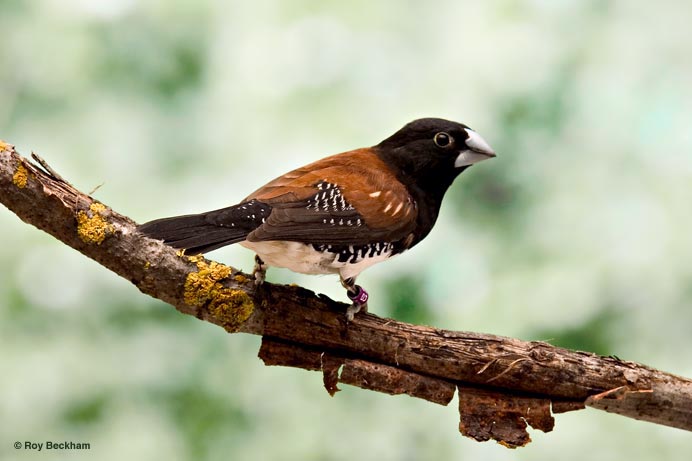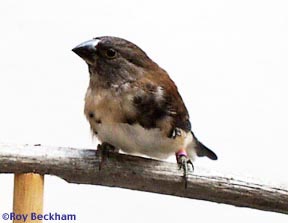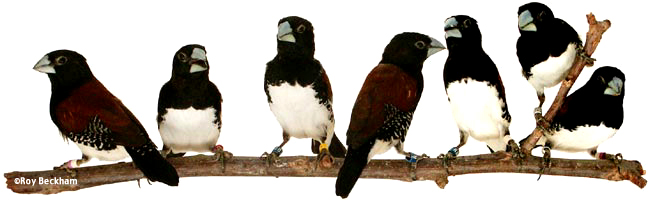




 |
|
|||||||||||||||||||||
 |
|
|
|
|
|
|
|
|
|
|||||||||||||
|
|
|
|
|
|
||||||||||||||||||
|
|
|
|
|
|
|
|
|
|
||||||||||||||
|
|
|
|
|
|
||||||||||||||||||
|
|
|
|
|
|
|
|
|
|
||||||||||||||
|
|
|
|
|
|
||||||||||||||||||
|
|
|
|
|
|
|
 |
|
|||||||||||||||
 |
 |
|
||||||||||||||||||||
|
|
|
|
||||||||||||||||||||
|
|
|
|
|
|
|
|
|
|
|
|
|
|
|
|
|
|
|
|
|
|
|
|
| Rufous-Backed Mannikin - Lonchura nigriceps | ||||
 |
||||
| Rufous-backed mannikin. | ||||
|
Common Names Description Diet
The clutches ranged from 4-7 eggs with incubation starting on the 3rd or 4th egg. The incubation period lasts about 13 days and the extremely tiny chicks hatch out with very little down. The first clutch I hatched was under society fosters and I had serious doubts about their ability to feed something so small. They did very well under society finches though. The imported RBMs would sit diligently enough, but would eject many of the young. I'm hopeful that the domestically raised Rufous will be better parents than the imports since they are used to my birdroom routine and foods. The chicks are ready to fledge in about 20 days (1 week old chicks). The young are dusky gray-brown with a brownish back. They are weaned at about 3 weeks and should stay with either the parents or fosters until you are sure they are independent. You will notice some interesting behavior after fledging that seems to be typical of African mannikins. The begging young will raise an opposing wing when being fed. This seems to make the chick look bigger as well as block the parents from the clutch mates. The fledglings will return to the nest at night to roost with the parents. The molt into adult colors occurs rapidly and begins at around 1 month after independence. (Update: 2/2002) Since raising my first young under society finches, I have been successful in raising young under the Rufous-backs. I paired fostered x imported and fostered x fostered in 15" x 18" x 17" cages. I was also successful in getting a pair of imports to breed in the same conditions. I offered half open nest boxes with the same coco fiber and white feathers that were offered to the original imports. Some pairs would sit very tightly on the nest and would always have at least one bird in the nest until the chicks were ready to fledge. All the birds raised their young on a seed and eggfood diet. As the chicks reach independence, a close eye must be kept on them. The parents will begin to drive them away and I believe that the male will drive any male fledglings even harder. If they begin this, it is best to remove them quickly. The can be killed by the parents. (Interestingly enough, I saw this behavior more from the imports than from the pairs that included a fostered male) Additional Notes As breeding season approaches and the birds come into condition, watch them closely if you house them in groups. The word I've seen applied to RBMs is unpredictable. One day they may be calm and peaceful and the next you'll find weaker birds being mercilessly chased to exhaustion or death. Same goes when mixing individuals or smaller groups with an already established group. If you're going to mix to groups of adults or a lone adult to a group, try to move all the birds to a new cage at once. By the time they figure out what's going on they have formed a new colony. Sometimes adult birds will give fledglings a little more latitude when being introduced together. Probably the lack of markings and dark bill are indicators to the adult that the new bird is not a threat. Still, be cautious. The young are no match for an aggressive male that is clearing his space and are easily killed. Mouth markings are typical of the lonchura family. The African mannikins have a "double horseshoe" shape that is distinct from the Asian mannikins "single horseshoe" pattern. The tongue, which is also marked, will flutter back and forth following the pattern of the upper palette markings. The old Latin name suggested that the Rufous is a subspecies of the Black and White mannikin (Lonchura bicolor), but the Rufous-back is now classified as a distinct species (Lonchura nigriceps). |

Immature Rufous-backed mannikin beginning molt into adult plumage
Clutch of 3 in the nest...See mouth markings on the Gape Page

